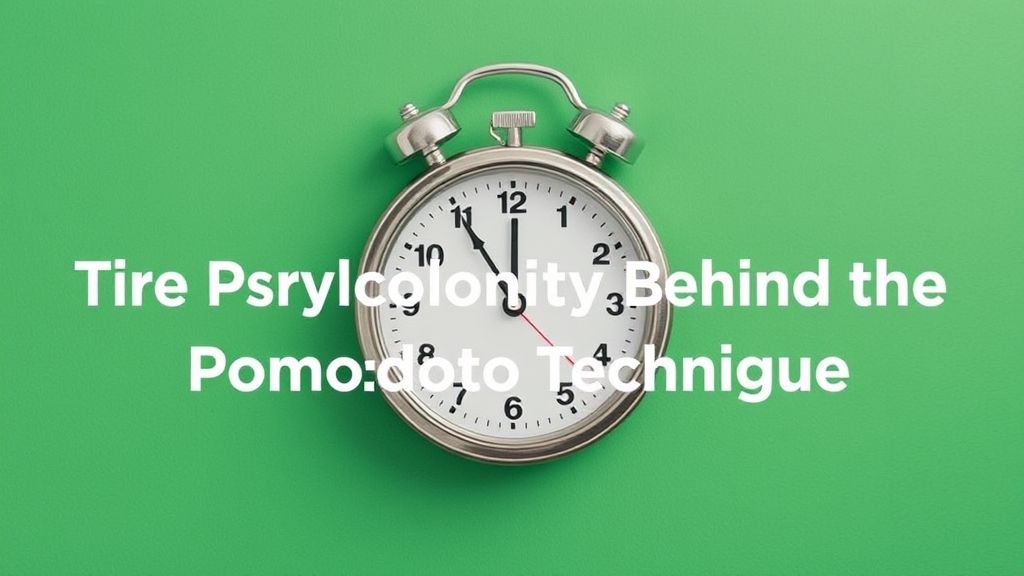Let’s be honest concentration is tough, especially when working from a computer from home. Before you know it, you are composing that e-mail, but now you are reading the contents of the refrigerator or going through your phone without even being aware of the reason. Despite all your best intentions, it can be so easy to be distracted, overwhelmed, or stuck half-working, half-procrastinating from dawn until dusk.
That is where the Pomodoro Technique comes in.
It’s not some fancy system of productivity or trendy hack. It’s a ridiculously easy mode of organizing your time so that your mind calms down and gets going. A timer, some discipline, some well-deserved breaks that’s all it requires to turn distracted attention into deep concentration.
Here, we’re going to dissect exactly how the Pomodoro Technique works, why it works so well (specifically if you work from a home office), and how you can start using it today to get more done without burning out.
Let’s begin – one Pomodoro at a time.
How the Pomodoro Technique Can Transform Your Focus
Working from home has its perks no commute, more flexibility, and the ability to wear sweatpants without judgment. But it also comes with distractions: the fridge, your phone, laundry, noisy neighbors, and sometimes, just the overwhelming quiet. Staying focused while working remotely isn’t easy, especially when your couch is within reach. This is where the Pomodoro Technique can seriously change the game.
Let’s break down how this simple time-management method can sharpen your focus, reduce burnout, and actually help you get more done in less time.
What Is the Pomodoro Technique?
The Pomodoro Technique is a productivity method developed by Francesco Cirillo in the late 1980s. It’s named after the tomato-shaped kitchen timer he used as a university student (Pomodoro means tomato in Italian).
Here’s how it works:
- Pick a task you want to work on.
- Set a timer for 25 minutes this is called one “Pomodoro.”
- Work on the task, distraction-free, until the timer rings.
- Take a 5-minute break.
- After four Pomodoros, take a longer break (15–30 minutes).
It’s working for your brain, not against it. We all try to grind through long stretches of work, thinking that more hours translate to more productivity. But attention isn’t that linear. It breaks that thinking by having you work for small, intense bursts of time – and purposeful breaks in between.
Instead of promising to sit down to “work all morning,” you promise only 25 minutes of undivided concentration on a given task. That small block of time makes beginning a little more manageable, and that helps fend off the temptation to delay. You’re not promising to complete everything – just to work without distractions for that small period.
Once the timer goes off, you rest for a few minutes. Guilt free. Burnout free. These rest breaks aren’t lost time – they give your brain a chance to process what you just did and gear up for the next round.
The overall system consists of a cycle of four 25-minute sessions (Pomodoros), which are broken up with 5-minute breaks between, and a 15–30 minute break after the fourth cycle. Don’t feel, though, that you need to be that exact to benefit from the system. You can start with a 25-minute Pomodoro and adjust from there.
What works best is the simplicity. No learning curve, no fancy tools, no thinking too much. Just a timer and a little bit of discipline. And the best bit? It is just as effective whether writing, coding, designing, reading, or organizing via your inbox. For a remote working setup where boundaries between focus time and distractions are blurred the Pomodoro Technique imposes just enough formality on a day such that you are productive without being too rigid.
Why It Works: The Psychology Behind the Pomodoro Technique
Actually, the power of the Pomodoro Technique lies not only in having a timer set but in that it works off of the way our brains naturally operate.

Let’s start small: your brain doesn’t enjoy open-ended tasks. If you tell yourself, “I’m going to complete this report today,” your brain can’t figure out where to begin or where to stop. That kind of vague plan creates mental resistance, which more often than not expresses itself as putting things off. But if you tell yourself, “I’m going to work on this for the next 25 minutes,” now that seems manageable. You’ve provided yourself with a definite start point and a definite end point and that is something that your brain can understand and consent to.
Another fundamental manner in which it is effective is the manner that it addresses attention span. All of us feel that we can provide attention for hours on end, but research tells us that we start losing focus after we’ve been working diligently for about 20 minutes. Instead of yanking your attention through a never-ending bout of work, the Pomodoro approach includes breaks that are taken through the day before your head is literally burnt. It works with your limits of attention, not beyond them.
It also reduces decision fatigue, which builds up every time we switch from two things or make a decision of what we are going to do next. Since every Pomodoro is a single exclusive task, we get rid of all of these small incessant decisions that are wearing us down. You stop going back and forth between tabs, browsing e-mails while working, half-doing three things at a time. That is when we are doing real work, not just keeping ourselves occupied. There’s even a reward system integrated. That one break every five minutes isn’t rest by itself it’s a mental reward. You’ve earned that. That tiny dose of satisfaction and completeness helps draw you back for another round. In the long term, that cycle builds a cadence that even feels better to repeat.
This method taps into two key psychological drivers:
- Time pressure boosts motivation. When you know you’ve only got 25 minutes, you’re more likely to stay on task.
- Breaks prevent burnout. Short pauses help your brain process what you’ve just worked on, making your next session more productive.
Finally, there is something satisfying about watching your sessions add up. Whether you’re keeping a piece of paper or computer program track of Pomodoros, watching your total incremented in small 25-minute chunks helps more than staring at the clock all day.
Bottom line: the Pomodoro Technique works because it works with the way our brains naturally focus, unwind, and respond to limits. It doesn’t put a grind on you it frees you to work more intensely with less stress.
The Pomodoro Technique for Remote Work
Working from a distance puts the day’s rhythm entirely in your hands and that is a boon and a bane. No person moving through your office. No face-to-face encounters to break up the day. No expressed indications of when to work or rest. That is why so many telecommuters can’t seem to stay on course or never quite “clock off.”
The Pomodoro Technique fills that gap with precisely the right amount of formality not so formal that it almost qualifies as micromanagement, but sufficiently that you don’t float aimlessly through the day.
One of the biggest challenges of working from home is having boundaries that are not clearly defined. You might start your day with a clean mental head, but distractions are a different proposition when working alone. A pile of dishes, a chatterful neighbor, extraneous pings even small issues can chip away at your concentration. The Pomodoro approach helps you with mental “walls” for your time of focus. You’re not just working, necessarily, but committing yourself to a task for a tiny, discrete amount of time. It’s almost like setting a Do Not Disturb sign on your mental bulletin board, even without a home office.

It’s also a beautiful buffer against working for too long, which happens more often than you’d think with remote work. Without a commute or set hours, many find themselves working more without even realizing it. The Pomodoro rhythm inserts some punctuation back into your day. Those regular breaks are reminders to get up, stretch, and ask yourself how you’re doing. They create the space to breathe – something that gets lost when your work life becomes your personal life. Another advantage? It keeps you accountable without a manager having to come to your office. When working in an office, there is a form of passive accountability from simply being around other people. At home, it is so easy to simply lose hours without actually making real progress. With Pomodoros, you’re adding your own checkpoints. You can look back at your day and literally see how many concentration sessions you got completed not just for how long you’ve spent sitting at your laptop.
For anyone juggling deep work and shallow work, Pomodoro assists. You can apply the intense sessions to the former high-priority work and leave the latter ones for the emails or office work. It is a shrewd way of having your energy aligned with the nature of work that you are undertaking, rather than simply reacting to whatever arises next.
And last, but certainly not least, getting started becomes easy. When energy is low which we all feel from time to time “I’ll just do 25 minutes” is a lot less intimidating than writing a finished report or cleaning out your inbox. It eases resistance and gets you moving, and more often than not, momentum gets the better of inertia.
Here’s how it helps:
1. Creates a Work Rhythm
Without the structure of an office, it’s easy to fall into chaotic or uneven work patterns. Pomodoro sessions create a predictable cadence 25 minutes of deep focus followed by rest. This rhythm trains your brain to shift in and out of concentration smoothly.
2. Reduces Screen Fatigue
Remote work often means long hours staring at screens. Micro-breaks give your eyes, posture, and brain a moment to reset, reducing strain and boosting clarity.
3. Helps Avoid Multitasking
Multitasking feels productive, but it actually reduces output and increases mistakes. With Pomodoro, you commit to one task per session. That single-task focus improves both speed and quality.
4. Easier to Measure Progress
Remote workers often miss the instant feedback you’d get in a shared office. By tracking your Pomodoros, you get a clear sense of how much work you’ve actually done in a day.
How to Start Using the Pomodoro Technique (Even If You’re a Chronic Procrastinator)
Let’s be real: if you’re the kind of person who watches productivity videos instead of doing the actual work, the idea of following a technique even a simple one can feel like a joke. But that’s exactly why the Pomodoro method is worth trying. It’s not about turning you into a productivity robot overnight. It’s about building momentum with tiny wins.
So if you’re used to putting things off until the last possible second, here’s how to ease into it without overwhelming yourself:
1. Forget the Perfect Setup. Just Start.
You don’t need a new app, a fancy notebook, or a tomato-shaped timer. Procrastinators love getting ready to be productive so much that they never actually begin. Don’t fall into that trap. Use the timer on your phone, or Google “online Pomodoro timer” and press start. That’s it.
The first Pomodoro isn’t about efficiency. It’s about showing up.
2. Pick One Ridiculously Simple Task
Don’t start with something massive like “clean my inbox” or “finish the report.” Instead, pick a task that takes zero emotional effort: rename a file, outline three bullet points, or answer one email. Starting small builds trust with yourself. Once you get through one Pomodoro without bailing, you’ll feel way more confident to take on something bigger.
3. Set a Timer and Don’t Overthink It
When the timer is on, the only rule is: stay with the task. You’re not trying to do your best work ever—you’re just trying to stay focused. You’ll be tempted to check your phone, open another tab, or wander into the kitchen. That’s normal. Expect it, but don’t give in.
If you’re halfway through and your mind is all over the place, stay seated and ride it out. This part gets easier with time.
4. Use the Break Don’t Skip It
Procrastinators often feel guilty once they actually get started, so they try to make up for lost time by skipping breaks. That usually backfires. Taking the 5-minute pause helps your brain reset. Stretch. Walk around. Breathe. The break is part of the work it’s what keeps you from burning out or zoning out.
5. Track Progress Without Judgment
At the end of the day, jot down how many Pomodoros you finished. It doesn’t matter if it’s one or six. The point isn’t perfection it’s proof that you’re capable of getting started. That record becomes motivation for the next day. You’ll start to realize how 25 focused minutes here and there actually add up fast.
6. Adjust the Length If You Need To
The original method uses 25-minute sessions, but if that feels like too much, go shorter. Try 15 or even 10 minutes to build up your tolerance. The important part is committing to something, even if it’s small. As your focus muscle gets stronger, you can slowly stretch the time.
The truth is, procrastination isn’t laziness it’s often a mix of perfectionism, fear of failure, or just plain overwhelm. The Pomodoro Technique cuts through all of that by giving you permission to start small, stay focused for a short time, and then stop. It doesn’t ask for all your energy it just asks for a little at a time.
And that’s usually all it takes to get moving.
Common Mistakes to Avoid
The Pomodoro Technique might be simple, but using it effectively? That’s another story. Plenty of people start with good intentions, only to run into common pitfalls often because they’re overthinking it or using it the wrong way. If you’re looking to build Pomodoro into your day without burning out or getting frustrated, here are some mistakes to avoid:
1. Confusing It With a To-Do List
Pomodoro isn’t meant to replace your to-do list it’s a tool to help you work through it. But many people flip the script and plan their day by trying to “fit in” eight Pomodoros, instead of asking, “What do I actually need to get done today?” Focus on your priorities first, then use Pomodoros to tackle them with intention.
2. Expecting Every Session to Be “Deep Work”
Not every 25-minute chunk needs to be a burst of brilliance. Some tasks are just boring but necessary like replying to emails or organizing your files. And that’s fine. The magic of Pomodoro isn’t in peak performance every session; it’s in showing up steadily, one focus block at a time.
3. Overloading Your Schedule With Back-to-Back Pomodoros
It’s tempting to plan your whole day like a puzzle of Pomodoros. But things rarely go exactly as planned meetings go long, your energy dips, life gets in the way. Leave breathing room. If you only check off half your blocks, that’s not failure it’s being human.
4. Turning Breaks Into More Work
Those 5-minute breaks? They’re not there so you can sneak in more tasks. They’re for actual rest. If you don’t let your brain unplug even briefly you’ll just burn out faster. So stand up, stretch, sip water, stare at a tree. Whatever gives your brain a breather.
5. Multitasking Mid-Pomodoro
One Pomodoro = one task. If you’re bouncing between writing, checking emails, and responding to Slack, you’re not focusing you’re just busy. Guard those 25 minutes. When you commit to a single task, not only do you work better, but the break feels well-earned.
6. Feeling Like You’ve Failed When You Miss a Day
There’s no perfect streak here, no leaderboard. Some days, life will throw curveballs, and you might not get to a single Pomodoro. That’s okay. The goal isn’t perfection it’s progress. Miss a day? Just start again tomorrow. The habit grows in the showing up.
At the end of the day, Pomodoro isn’t about turning yourself into a productivity robot. It’s about creating a rhythm that helps you stay focused, without the stress. You’ll fumble a few times everyone does. But if you tweak it to fit your real life, not some Pinterest-perfect plan, it can really work.
Keep it simple. Use what clicks. Ditch what doesn’t. The real win is in building the habit of showing up not crushing every single session.
Real-Life Example: Remote Content Writer Using Pomodoro

Imagine this: you’re a freelance content writer working from a small apartment. Your “office” is a corner of your kitchen table. The neighbors decide to practice their tuba (or whatever that sound is) right at 11 a.m., and your brain keeps whispering, “Shouldn’t we be folding laundry instead?”
You’ve got a deadline a 1,500-word blog post due by the end of the day. Totally doable, but for some reason, you’ve opened the doc three times and only squeezed out 40 words. You’re distracted. Bored. Somehow tired even though you just had coffee. Sound familiar?
Here’s how the Pomodoro Technique can pull you out of that fog and get that draft done:
🕘 9:30 AM – Pomodoro 1: Brainstorming
Set a 25-minute timer and lower the pressure you’re just outlining. Sketch out your main sections: intro, a few key points, and a rough conclusion. It doesn’t need to be pretty. When the timer buzzes, you’ve got a roadmap. You’re no longer staring into the content void.
Break (5 min): Stretch, hydrate, look out the window. Nothing fancy just step away for a moment.
🕤 10:00 AM – Pomodoro 2: Writing the Intro
Back at it. This round’s about getting the intro out, not making it perfect. Midway through, you feel the itch to obsess over the first sentence but you resist. The goal is flow, not perfection.
Break (5 min): Airplane mode on. Phone down. You sit quietly. Breathe. Suddenly, your brain feels a little more grounded.
🕙 10:30 AM – Pomodoro 3: Writing Core Sections
Now you’re into the main event maybe two chunky sections of the blog post. You’re not polishing yet, just getting ideas down. The timer keeps you from spiraling into overthinking. You’re moving faster than you expected.
Break (5–10 min): Refill your coffee. Stay off email. Let your mind wander a bit.
🕦 11:00 AM – Pomodoro 4: First Pass at Edits
Time to clean up what you’ve got. You connect ideas, trim some fluff, and start shaping your voice. It’s not done, but it’s starting to look like a real article now not just fragments.
Long Break (20 min): Step away. Music, laundry, snacks whatever helps your brain unplug for real.
🕛 12:00 PM – Optional Pomodoro 5: Final Polish
You’re back after lunch with fresh eyes. This is where you fine-tune the tone, adjust the title, and catch those sneaky typos. Then you hit Send. Done and done and it didn’t even take the whole day.
Why It Works
This method works with your brain, not against it. You don’t need superhero motivation or a Pinterest-worthy workspace. You just need to commit to the next 25 minutes. Do that a few times, and you’ve got momentum and eventually, a finished piece.
For remote writers especially, Pomodoro is a total game-changer. Instead of drifting from task to task (or chore to chore), you create focused windows where work actually gets done without the usual stress spiral.
So next time you’re stuck in procrastination mode, don’t panic. Just set a timer and take the first step. The rest will follow.
Helpful Tools to Make It Easier
While a basic timer works, here are a few tools designed for remote workers using the Pomodoro technique:
- ✅ Focus To-Do (App) – Combines a Pomodoro timer with task management.
- ✅ Forest App – Helps you stay off your phone by “growing” virtual trees during Pomodoro sessions.
- ✅ Session – A clean, minimalist productivity timer with analytics and journaling features.
Bonus Tip: Pair It With Time Blocking
If you’re a Google Calendar user, try scheduling blocks of Pomodoro sessions in your calendar. For example:
- 9:00 – 11:00 AM: 4 Pomodoros
- 2:00 – 4:00 PM: 4 Pomodoros
This adds structure to your day while leaving room for meetings or unexpected tasks. It’s a great combo for remote workers juggling deep work and collaboration.
Conclusion
The Pomodoro technique for remote work isn’t a magic trick but it’s a simple, repeatable habit that brings structure, reduces overwhelm, and helps you stay focused without frying your brain. If you’re struggling to stay productive at home, try it for just one day. You’ll be surprised how much easier it is to get into the zone.
Start small. Set your first timer. One Pomodoro at a time.




